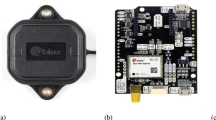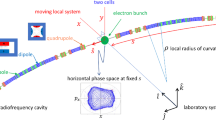Abstract
Results of the continuous ground-based monitoring of the cosmic ray flux by neutron monitors are used as an experimental material for many works devoted to studying cosmic ray variations. Long-term stability of detectors is the problem of an extreme importance. Two independent methods for estimating long-term stability of neutron monitor operation have been proposed. The quantitative estimates have been obtained for 90 detectors that operated and have been operating during more than one solar cycle. The conditions responsible for long-term stability of a detector and the causes of instability have been considered.
Similar content being viewed by others
References
T. M. Aleksan’yan, A. V. Belov, V. G. Yanke, et al., “Experimental Studies of Geomagnetic Effects in Cosmic Rays and an Increase Effect Spectrum before Magnetic Storms,” Izv. Akad. Nauk, Ser. Fiz. 46(9), 1689 (1982).
Database of the Global Neutron Monitor Network. //ftp://cr0.izmiran.rssi.ru/COSRAY!/FTP_NM/C/.
A. Belov, L. Dorman, R. Gushchina, and V. Yanke, http://cr0.izmiran.rssi.ru/STATION/editor.htm.
A. V. Belov, R. T. Gushchina, L. I. Dorman, and I. V. Sirotina, “Rigidity Spectrum of Long-Term Variations in Cosmic Rays,” Geomagn. Aeron. 28(4), 550 (1988).
A. V. Belov, R. T. Gushchina, L. I. Dorman, and I. V. Sirotina, Preprint No. 88 (1035), IZMIRAN (Institute of Terrestrial Magnetism, Ionosphere, and Radiowave Propagation, Russian Academy of Sciences, 1993).
A. V. Belov, R. T. Gushchina, and V. G. Yanke, “Long-Term Cosmic-Ray Variations: The Rigidity Spectrum,” Geomagn. Aeron. 38(4), 131 (1998) [Geomagn. Aeron. 38, 506–509 (1998)].
A. V. Belov, Ya. L. Blokh, E. G. Klepach, and V. G. Yanke, “Primary Processing of CR Station Data: The Algorithm, Computational Program, Realization,” Kosm. Luchi, No. 25, 113 (1988).
D. F. Smart and M. A. Shea, “World Grid of Calculated Cosmic Ray Vertical Cutoff Rigidities for Epoch 1990,” in Proceedings of the 25th ICRC, 1997, vol. 2, p. 401.
http:/cr0.izmiran.rssi.ru/LongTimeVarCR/LongTimeStab/main.htm.
Author information
Authors and Affiliations
Additional information
Original Russian Text © A.V. Belov, R.T. Gushchina, E.A. Eroshenko, K.F. Yudakhin, V.G. Yanke, 2007, published in Geomagnetizm i Aeronomiya, 2007, Vol. 47, No. 2, pp. 267–271.
Rights and permissions
About this article
Cite this article
Belov, A.V., Gushchina, R.T., Eroshenko, E.A. et al. Estimation of long-term stability of detectors within the global network of neutron monitors. Geomagn. Aeron. 47, 251–255 (2007). https://doi.org/10.1134/S0016793207020144
Received:
Accepted:
Issue Date:
DOI: https://doi.org/10.1134/S0016793207020144




